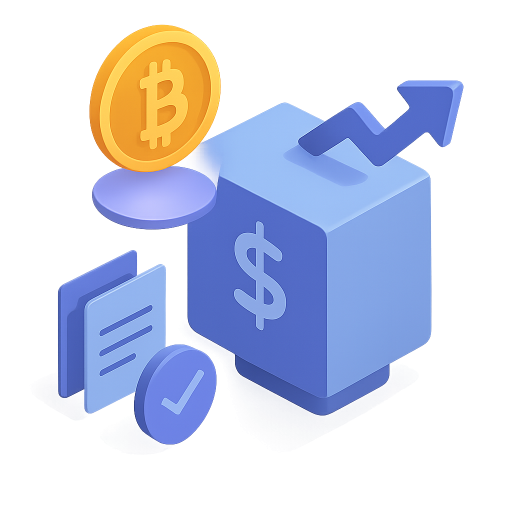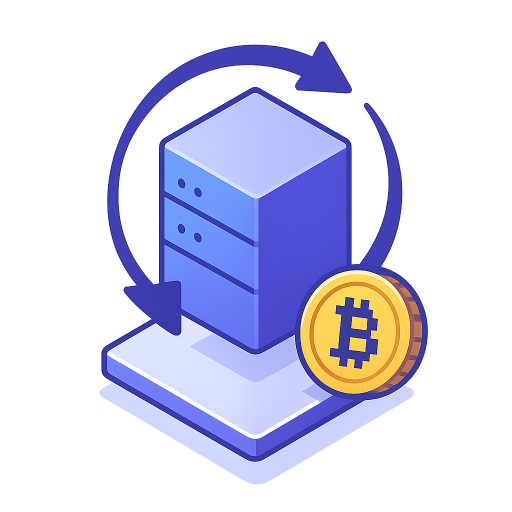Yield Farming & Liquidity Mining
Maximize DeFi Returns in 2025
Intro | Types | Guide | Opportunities | FAQs

Introduction
What Is Yield Farming?
Yield farming – also known as liquidity mining – is one of the most popular ways to earn passive income with cryptocurrency in decentralized finance (DeFi). In simple terms, it involves deploying your crypto assets into DeFi protocols (like decentralized exchanges or lending platforms) to earn rewards, often at much higher rates than traditional banking. These rewards typically come from fees and incentive tokens distributed by the protocol. Yield farming and liquidity mining are central to passive income in DeFi because they incentivize users to provide liquidity, which in turn fuels DeFi services like trading and lending. (Centralized crypto platforms also offer yield products, but here we focus on DeFi strategies – see our comparison with CeFi later.) It’s now 2025, and many investors are searching for the best yield farms 2025 has to offer – but before chasing high returns, it’s critical to understand how yield farming works and the risks involved. This guide explains DeFi yield farming and liquidity mining from the ground up, in a beginner-friendly way, and provides an evergreen reference to all major aspects of DeFi-based yield strategies.
Yield farming refers to strategically moving and staking crypto assets in various DeFi platforms to generate high yields, often paid in new token rewards. Liquidity mining is closely related – many use the terms interchangeably. Both involve depositing tokens into smart contract liquidity pools to earn rewards. Liquidity mining focuses on providing assets to a pool for the platform’s token, while yield farming is broader, often hopping between platforms for optimal yields.
Origins: Yield farming exploded in “DeFi Summer” 2020, sparked by Compound’s COMP token rewards. Protocols like Uniswap and SushiSwap followed, distributing tokens to liquidity providers. This created a new passive income avenue: deposit tokens into pools or contracts, and earn high APYs plus governance tokens.
In summary, yield farming = liquidity mining in practice: lock crypto in DeFi for yield (interest + rewards). It powers many DeFi passive income strategies. Next, the mechanics.
Introduction
How Yield Farming Works
Yield farming uses smart contracts to reward liquidity providers. Here’s a detailed breakdown:
- Liquidity Provision: Deposit into a DEX pool (e.g., Uniswap ETH/USDC) or lending protocol (e.g., Compound) to become an LP. This supplies the liquidity traders or borrowers need, starting your earning process. Your contribution helps the protocol function smoothly, like fueling a marketplace.
- LP Tokens: Receive LP tokens as a receipt, representing your share and fees. These tokens track your contribution and let you withdraw proportional assets plus accrued fees. They’re essential for claiming rewards in farms.
- Staking for Rewards: Stake LP tokens in a farm (e.g., SushiSwap’s MasterChef) for extra tokens beyond fees. Farms are incentive programs to boost liquidity, distributing protocol tokens to stakers. This step turns basic liquidity providing into full yield farming.
- Incentives and Returns: Earn fees + reward tokens; APYs can hit triple digits, but fluctuate with demand. Compound by reinvesting for exponential growth, or swap rewards for profit. Yields combine fees from usage and tokens for participation.
- Vs. Holding: Puts idle crypto to work, earning on-chain while protocols gain liquidity. Unlike holding, it generates income during flat markets, turning passive assets active.
Example: Provide $1,000 ETH/$1,000 USDC to a pool, stake LP in a farm for 20% fee APY + 50% in tokens – potential 70% total, but with risks like price volatility.
Benefits of Yield Farming
Yield farming offers exciting advantages for investors and DeFi:
- High APYs and Tokens: Achieve double or triple-digit annual percentage yields, plus receive reward tokens that may increase in value, as seen with COMP’s early price surge that boosted overall returns.
- Passive Income: Turn idle assets into ongoing earnings, like a “crypto dividend,” productive even in flat markets.
- Governance Rewards: Gain voting tokens, letting you influence platforms as an owner.
- Composability: Stack strategies (e.g., LP as collateral) for layered, maximized yields.
- Diversification: Earn new tokens, expanding portfolios while engaging DeFi communities.
It aligns users with platform growth for rewarding crypto investing.
By being informed and cautious, these risks can be managed. Start small and diversify for a smoother experience.
Risks of Yield Farming
Yield farming can be rewarding, but like any investment, it comes with challenges to be aware of. Here’s a balanced look at the key risks, along with tips to manage them:
- Impermanent Loss: This happens when prices of pooled tokens diverge, potentially reducing your total value compared to just holding. It’s more common in volatile pairs. Tip: Choose stable or correlated assets, like stablecoin pools, to minimize impact.
- Smart Contract Exploits: Code vulnerabilities could lead to fund losses if exploited. Tip: Stick to audited, battle-tested protocols with strong security records.
- Volatility & Token Risk: Deposited or reward tokens can fluctuate in price, affecting returns. Tip: Diversify and monitor markets; use stablecoins for steadier yields.
- Rug Pulls & Scams: Some projects may be fraudulent, with devs withdrawing funds. Tip: Research teams, audits, and community feedback; avoid unverified platforms.
- Gas Fees: Transaction costs, especially on Ethereum, can eat into profits. Tip: Use low-fee chains like Polygon and batch actions.
- Complexity: Requires ongoing monitoring to avoid suboptimal returns. Tip: Start simple, use tools for tracking, and learn gradually.
Compare
Yield Farming vs. CeFi and Other Passive Strategies
Staking stands out among crypto passive income options for its balance of simplicity and network involvement, but how does it compare to alternatives like crypto lending or yield farming?

Vs. CeFi
CeFi (e.g., Nexo) is easier, stable; DeFi offers higher yields but more risk/control.

Vs. Staking
Staking (e.g., ETH) is simpler, lower risk/yield; farming amplifies returns with complexity.

Vs. Lending
Lending (Aave) is single-asset, stable; farming adds rewards but IL.

Vs. Liquid Staking/Nodes
Staking is on-chain earning; farming combines with it for stacking.
EXPLORE
Types of DeFi Yield Strategies
Yield farming varies by approach:
Start with pools, explore vaults for automation.
Liquidity Pools
Dual-asset (e.g., Uniswap ETH/USDC) earn fees + rewards; single-sided (e.g., Bancor) minimize IL.
Aggregators (Autofarm, Harvest)
Auto-allocate to best farms; optimize across protocols.
Multi-Chain
Farm on L2s/alternates (Polygon, Avalanche) for low fees; bridge assets, watch risks.
Auto-Vaults (Beefy, Yearn)
Auto-reinvest for higher APY; simplify but add contract risk.
Native Incentives (Sushi MasterChef)
Stake LPs for protocol tokens; bootstrap liquidity.

LEARN
How to Start Yield Farming (Step-by-Step for Beginners)
-
Set Up Wallet
Use MetaMask; back up seed phrase.
-
Fund Wallet
Get farming tokens + gas (e.g., ETH/USDC + ETH).
-
Choose Platform/Pool
Research reputable DEXs; pick low-volatility pairs.
-
Provide Liquidity
Deposit for LP tokens.
-
Stake LP Tokens
Farm for extra rewards.
-
Monitor/Harvest
Claim rewards; compound or sell.
-
Withdraw
Unstake LP, remove liquidity.
Start small; test on low-fee chains.
Monitor
Real-Time Farming Opportunities
As of July 25, 2025, top opportunities (APYs fluctuate; verify):
| Pool | Chain | APY |
TVL ($M)
| Rewards |
|---|---|---|---|---|
| USDC/USDT (Curve) | Ethereum |
15-20%
|
1,200
| CRV |
| ETH/USDC (Uniswap V3) |
Arbitrum
|
25-30%
| 800 | UNI |
|
stETH/ETH (Lido)
| Ethereum |
18-22%
| 500 | LDO |
|
DAI/USDC (Aave)
| Polygon |
12-15%
| 600 | AAVE |
|
CAKE/BNB (Pancake)
|
BNB Chain
|
40-50%
| 300 | CAKE |
|
GMX/GLP (GMX)
|
Arbitrum
|
30-35%
| 400 | GMX |
|
SOL/USDC (Orca)
| Solana |
22-28%
| 250 | ORCA |
|
WBTC/ETH (Balancer)
| Ethereum |
28-32%
| 350 | BAL |
|
FRAX/USDC (Frax)
| Optimism |
16-20%
| 200 | FRAX |
|
AVAX/USDC (Trader Joe)
| Avalanche |
35-40%
| 150 | JOE |
These figures are indicative—explore platforms for exact terms.
Understand
How We Review Yield Farming Platforms

APY Sustainability
Real activity vs. hype.

Audit & Security
Track record, audits, bounties.

Liquidity / Volume
High TVL/volume for stability.

Team / Transparency
Credibility, communication.

UX / Accessibility
Easy interfaces, multi-chain.

Community / Governance
Active DAOs, sentiment.

Innovation
Unique features vs. clones.
Clarify
FAQs About Yield Farming
Is yield farming safe?
It involves high risk—exploits, volatility, scams. Use audited platforms, start small, diversify. Not guaranteed; treat as venture investing.
How much money to start?
$100+ works; low-fee chains allow small amounts. Gas can eat profits. Compare on low-fee chains. Scale gradually.
Minimize impermanent loss?
Use stable pairs, IL-protected platforms, monitor prices, harvest often, hedge, or wait for reversion. Accept as yield cost.
Fees in yield farming?
Gas, protocol/performance fees, deposit/withdrawal, trading. Minimize with batching, low-fee chains, compounding.
